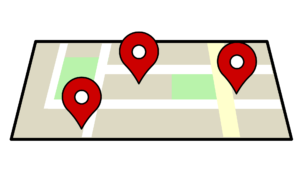Over the last 13 years, Google Maps API has been a cost-effective solution for website developers and owners, especially for those in the real estate industry, allowing the display of maps and geo-location of properties by address for a nominal fee (essentially free). Well, the easy road is over as all this is changing on July 16th.
 Google announced at the beginning of May that Google Maps Business is now Google Maps Platform, which brings new updates to improve location-based services. Benefits of the new platform is that Google consolidated 18 API’s under three core products, Maps, Routes, and Places. Free support and a simpler pay-as-you-go pricing model are included as new features to the platform.
Google announced at the beginning of May that Google Maps Business is now Google Maps Platform, which brings new updates to improve location-based services. Benefits of the new platform is that Google consolidated 18 API’s under three core products, Maps, Routes, and Places. Free support and a simpler pay-as-you-go pricing model are included as new features to the platform.
Sticker shock is what has everyone chattering about the new platform. Today, Google allows a website to call its mapping information 25,000 times a day free of charge, with overages of $0.50 per 1,000 calls over the 25,000 limit. The new fee structure changes all of this, as of July 16th, a website can call Google 28,000 times a month with a free monthly credit of $200. Once the website makes over 28,000 calls for the month, a charge of $7.00 per 1,000 calls is charged to your account. It’s now time for brokerages, MLSs, and technology vendors to revisit their website budgets.
Let’s look at some numbers. A website dishing out 750,000 listing pages containing a Google Map to a consumer can generate an expense of approximately $4,000 per month. Compared to today’s zero dollars for the same usage, this constitutes a significant increase in expenses to the tune of $48K per year.
Yes, we have been very fortunate over the years, but now is a good time to review a few things on how we utilize maps on a website.
Being smarter on when to call Google for information.
With the low-cost of Google Maps, developers have taken a short-cut by loading all the map information when a consumer loads a web page. The new strategy is to only call Google for map information that is viewable to the consumer when the page loads. All other map information that is not viewable is only called when the consumer clicks on it.
Most real estate websites have their map information to display property location, Street View option, and a map containing a point of interest (POI) information under a tab or below the page fold. The new strategy is to only make a call to Google when the consumer clicks to view the additional mapping information. If the consumer doesn’t view the map information, the website doesn’t incur a call against their account.
Search is another area to look at to minimize the number of calls to Google. Make your search result page default a Gallery View of the listings instead of the Map View. If you take this approach, make sure consumers who choose Map View will always have it as the default on their next visit to the website.
Implementing this strategy will take time and resources from the development team. Begin to plan and develop cost estimates on making this type of adjustment early as this information is needed to help determine the future direction of your business decisions.
Estimate the new monthly cost to make better informed business decisions.
Use the Google Cloud Platform to view the number of calls to Google Maps and estimate the new monthly cost based on the number of current calls. The reasons why it is important to know this are twofold:
• Eliminate the surprise in September of this new-found expense.
• Determine the ROI on either redesigning how maps and location-based services are implemented on the website and/or to decide if the business needs to spend time and resources to research and implement a new location-based service.
Begin to research and evaluate other location-based services.
I believe this is a smart move to begin no matter what the strategy. There are several location-based services available from reputable and stable companies. Google is not the only game in town, and it’s time to evaluate how the feature and function requirements designed into the website can be met with other solutions. Mapping (pun intended) the website requirements to other location-based services may lead to finding the best value for the money.
As a head start to research other location-based service, here is list of providers:
- OpenLayers – open-source JavaScript library and is capable of pulling tiles from other location-based services.
- Microsoft Bing Maps – JavaScript library is a very popular platform after Google.
- OpenStreetMap – project is maintained by volunteers who source and distribute mapping information across the world.
- MapQuest – several mapping product offerings and have been around since 2007.
- ArcGIS JavaScript – Esri released their first Internet based location-based service in 1996. Offers a full features and can be integrated with geo-spatial information.
- Mapbox – has been providing location-based services since 2010 and delivers digital mapping tools and custom maps.
- LeafletJS – open-source interactive maps. Very well documented API and is very lightweight for mobile devices.
- DigitalGlobe Platform – purely a MAP API and would require integration with a JavaScript Map Library like Mapbox or LeafletJS.
It may be that a hybrid approach of utilizing two or more of these products will be required to minimize or eliminate the costs of a new mapping strategy.
How does this impact my mobile native application?
The new pricing fees are only for websites, no matter what device is used to make a call to Google for mapping information. Google Maps for mobile native applications continue to be free. That is, free for right now. This will probably change in the near future.
Google only provided 10 weeks’ notice about the new changes. The decision to continue free map calls for mobile native apps was probably done so not to anger the entire development and business community.
All is good!
Look, we all knew that Alphabet, Inc and Google were providing mapping services basically for free to most businesses. The new pricing model still keeps the service free for those smaller websites and at a reduced cost to non-profits and educational institutions, but will grow Google’s revenue on websites who are the heaviest of users – real estate websites.
It would have been great if the pricing model was more reasonable. A 1,400% price hike is kind of insane. Other location-based service providers pricing models are more aligned with what businesses can afford.
How can “all be good”? This is going to drive more revenue to other companies in this space and create opportunities for innovation outside of Google. It will take a few years, but Google’s decision was bound to happen, and we need to take the opportunity to find new solutions.
WAV Group is happy to get on a conference call to assist on any of your development methodology and website architecture. Contact Victor Lund, Marilyn Wilson, or David Gumpper to schedule some time. Firms may schedule a private overview for their executive team or board by Camilla Harvey at Camilla@WAVGroup.com.





Keep in mind that many large providers within the industry were already paying for Google Maps so the impact to websites powered by providers, such as Delta, will have minimal to no impact in their pricing.
There is another aspect that complicates the mapping services being used: geocoding of listings. Most, if not all, of the map providers limit the use of their geocoding data to be used only with their mapping service. So, if you geocode with google you are not permitted to use that geocode data with another mapping service.